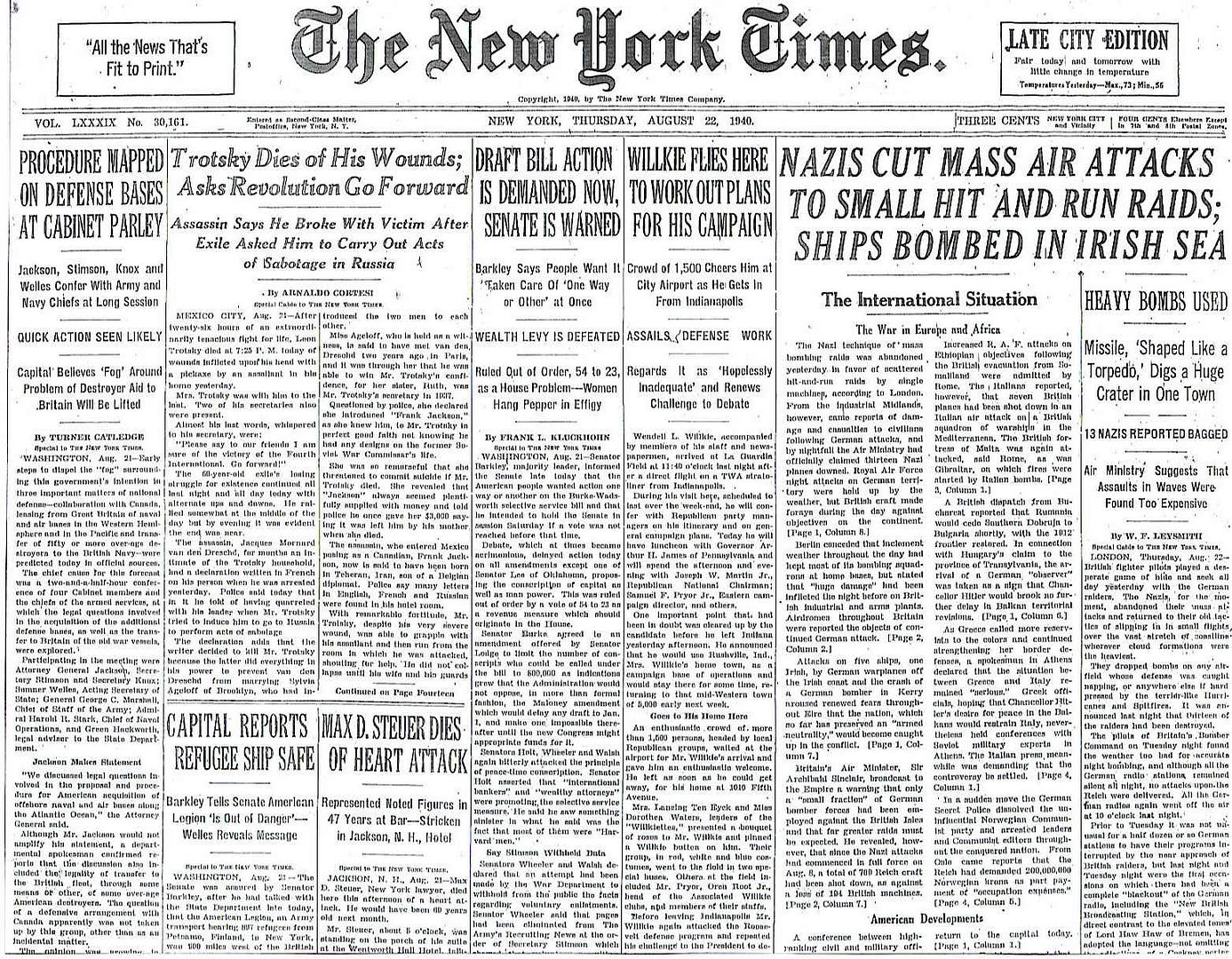
Posted on 08/22/2010 5:58:15 AM PDT by Homer_J_Simpson

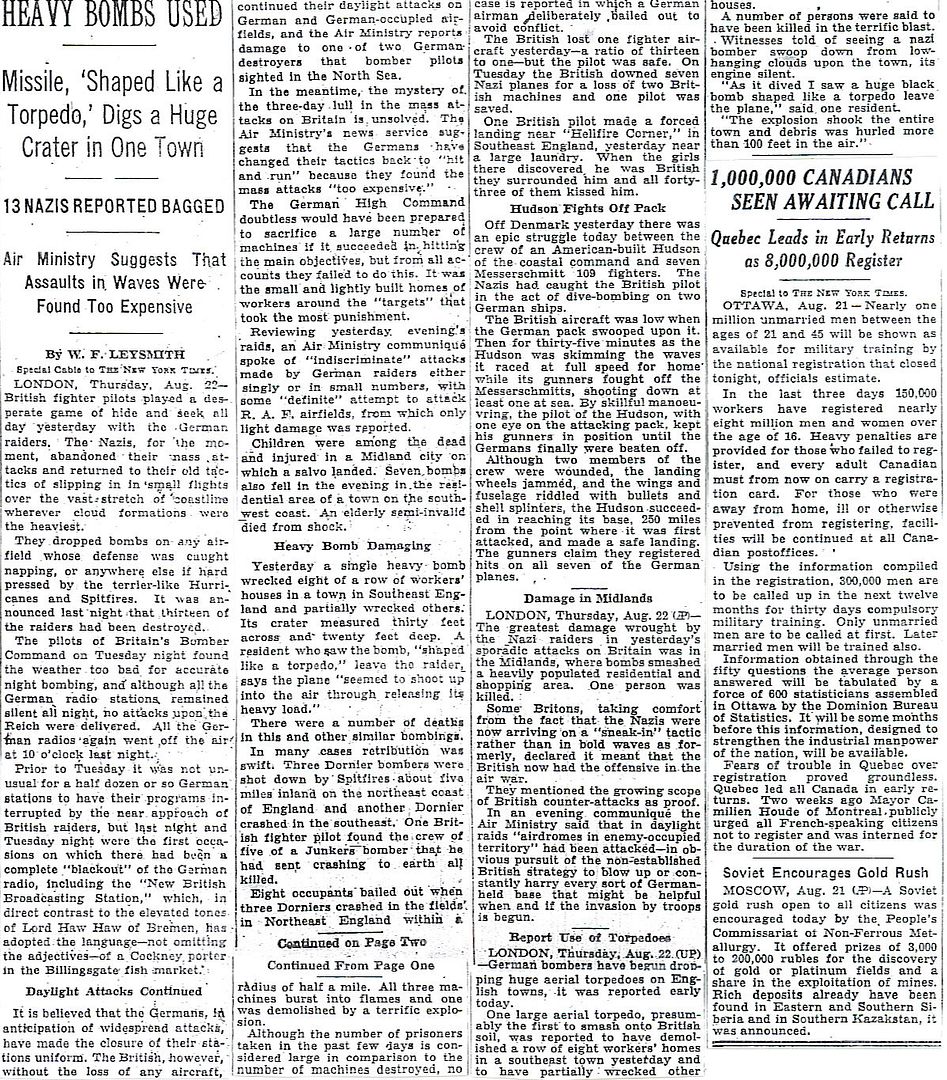

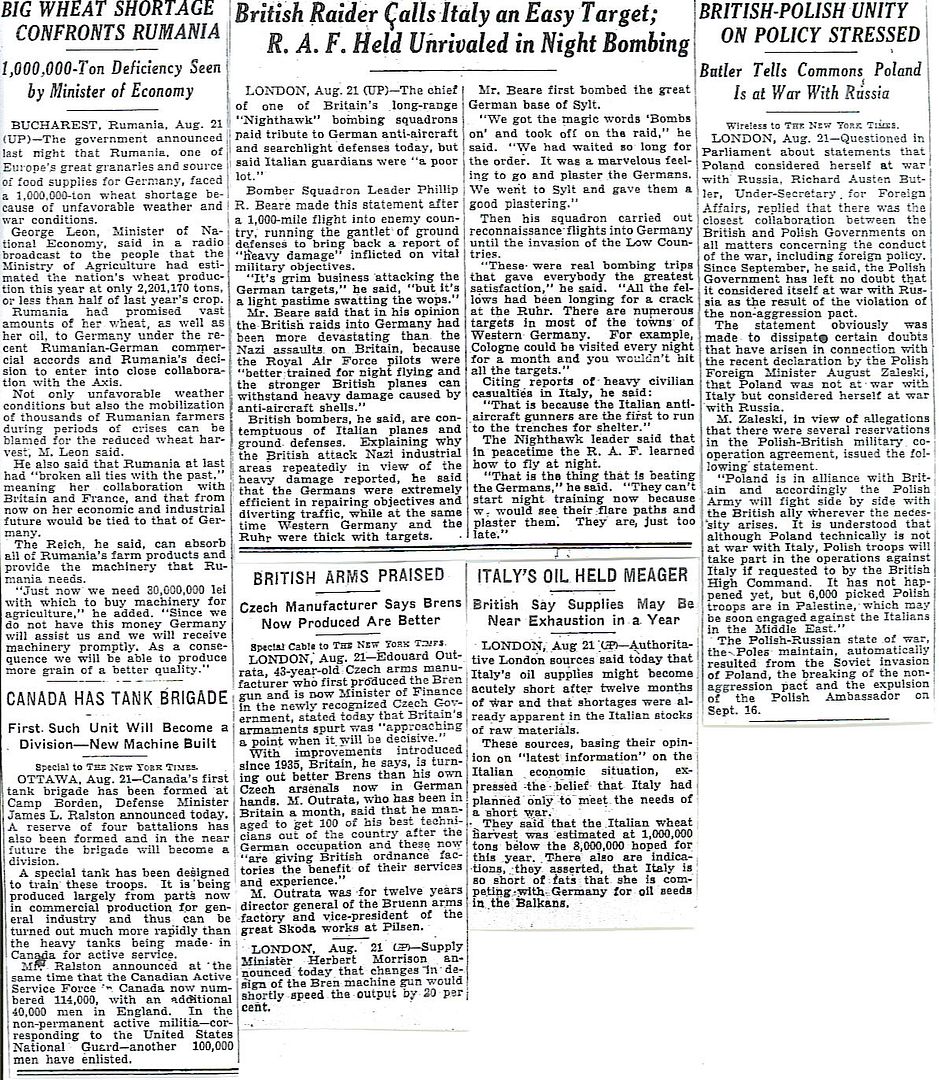

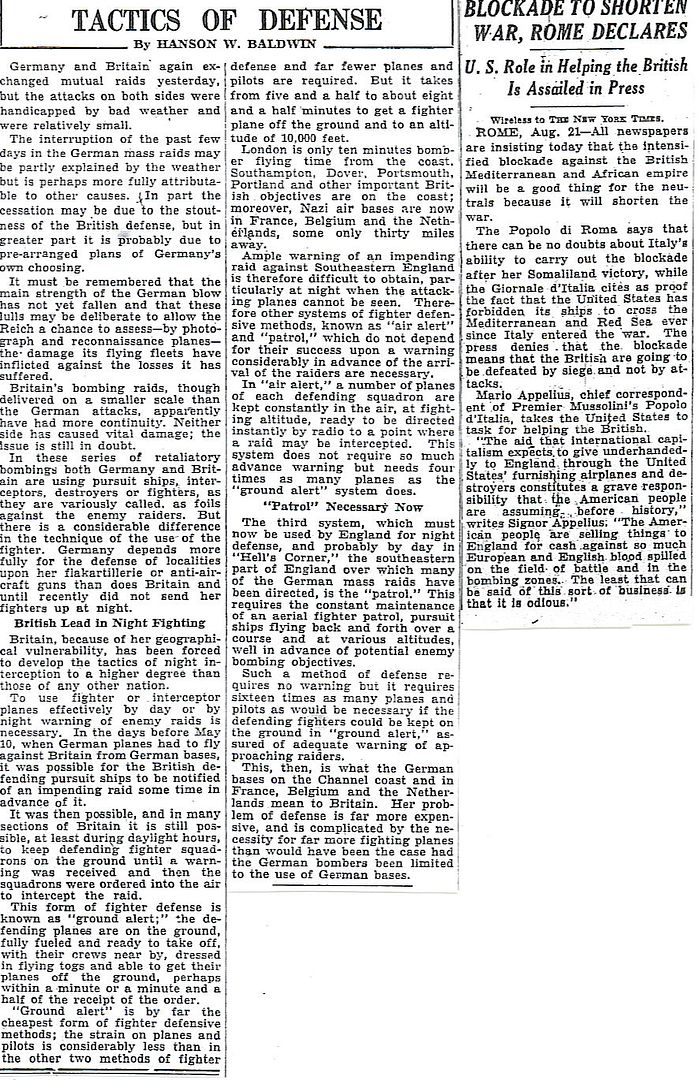
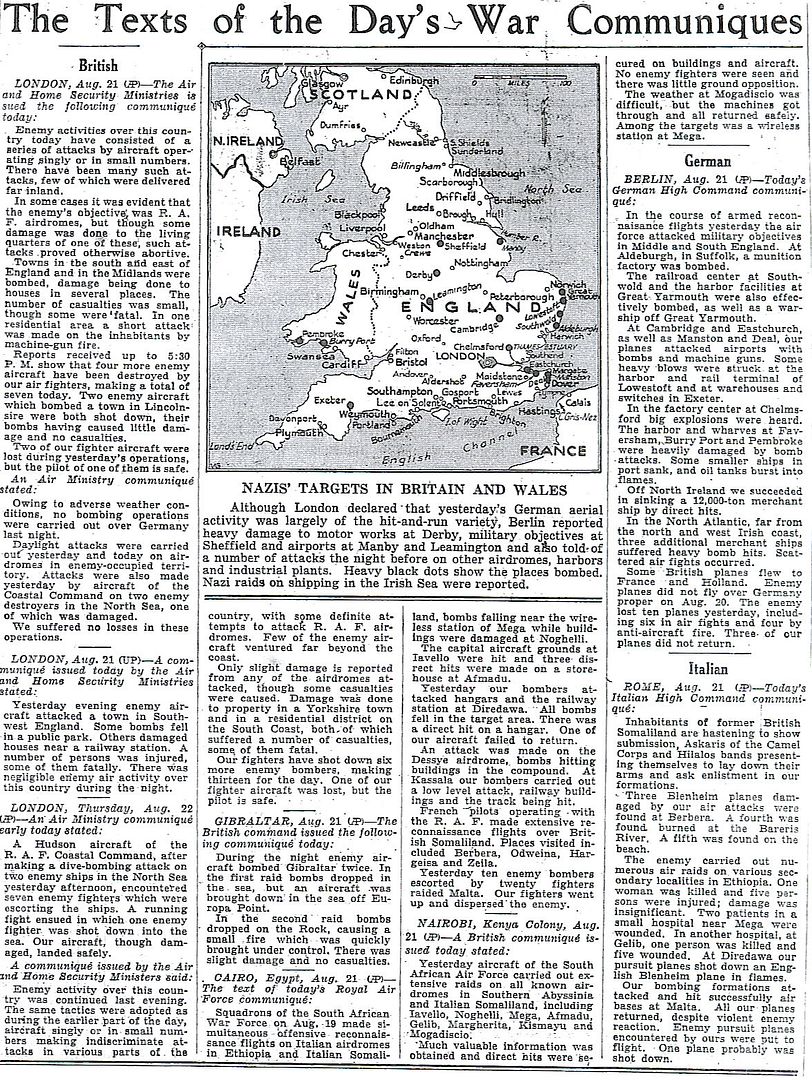
Plus a special guest map from Michael Korda’s, “With Wings Like Eagles,” showing the air defenses of England and Wales, August 1940.
http://www.onwar.com/chrono/1940/aug40/f22aug40.htm
German artillery bombards convoy
Thursday, August 22, 1940 www.onwar.com
In the English Channel... German artillery bombards a coastal convoy, near Dover, for 80 minutes without achieving any hits. In the evening, the guns bombard the town of Dover in England. A British 14-inch gun returns fire in what is the first of many cross-Channel artillery duels.
http://homepage.ntlworld.com/andrew.etherington/month/thismonth/22.htm
August 22nd, 1940
UNITED KINGDOM:
London: MPs bitterly condemn the internment of aliens.
Battle of Britain:
RAF Fighter Command: Luftwaffe attacks convoys in Dover Straits.
Attacks on RAF Manston.
At night Aberdeen, Yorkshire, Hampshire, South Wales, Bristol and Filton (airfield and Bristol Company’s works) are bombed.
Losses: Luftwaffe, 3; RAF 5.
Dover: German batteries shelled Dover tonight during a cross-Channel duel which had lasted all day. Their first target was a convoy of ships edging up the English side of the Channel under Royal Navy escort. Then the guns turned on Dover. In the air, RAF fighters broke up waves of Luftwaffe bombers. Other British aircraft hit back until nightfall. By then the convoy, with its 50,000 tons of food and war material, was snug at anchor.
The Germans have installed 14-inch batteries with a 20-mile range along the coast from Boulogne to Calais as part of the plan to invade England. Those guns were used for the first time today when shells sent water spouts 100 feet above the convoy. RN escorts laid smoke to conceal the convoy.
With dusk, the guns turned on civilian targets in Dover. During a 45-minute barrage a shell burst through the stained glass window of a church and exploded near the altar.
By midnight, refugees carrying bedding were seeking shelter as their homes were demolished. Across the Channel, the RAF lit up the gun pits with parachute flares, then bombed them.
Destroyer HMS Aldenham laid down.
Corvette HMS Gloxinia commissioned.
SS Thorold (1,689 GRT) Canadian merchant ship, was bombed and sunk by Luftwaffe Dornier Do-17 bombers, in the Irish Sea in position 51.46N, 005.38W. From her crew of 23, ten crewmembers were lost
(Dave Shirlaw)
GERMANY: British raiders bomb industrial targets at Frankfurt and Cologne.
German propaganda radio station NBBS prophesises the destruction of London by ‘aerial torpedoes carrying many tons of high explosive and guided by radio.’ [V1s ???]
GREECE: Athens: Britain promises to send air and sea forces to aid Greece if the enemy attacks.
MEDITERRANEAN SEA: Three Fleet Air Arm Swordfish deliver, arguably, the most interesting torpedo attack of the war. Having been informed of an Italian “depot ship” at An-el-Gazala, three Swordfish of HMS Eagle’s 824 Squadron, FAA, temporarily based at Ma’aten Bagush, are transferred to Sidi Barrani, equipped with auxiliary fuel tanks and torpedoes. In the late-afternoon, the three crews [Capt. O. Patch, RM (p)/Mid. G. J. Woodley, RNVR(o), Lt. N. A. F. Cheeseman, RN(p)/Sub-Lt. F. Stovin-Bradford, RN(o), and Lt. J. W. G. Welham, RN(p)/PO(A) A. H. Marsh(TAG)] headed out on the 180 mile flight to the Gulf of Bomba, routing 30 miles out to sea so as to approach the target from seaward. Approaching the target, they sighted the Italian Submarine Iride [the mother ship for Italian human torpedoes arriving to attack Alexandria] approaching on the surface. Heading straight for her, Captain Patch released his torpedo, which smacked Iride amidships, sinking her.
Having had no opportunity to attack themselves, the other two continued on the mission assigned. As they approached, they discovered the depot ship [Monte Gargano (1,976 GRT)] with a submarine and a destroyer tied up along side. Both torpedoes ran true into the pack, the resulting explosions “sinking whole bloody lot”. Initially treated with distain when they reported sinking four ships with three torpedoes, the crews were quite exuberant when recon photos the next morning verified that all three in harbour had, in fact, sank, though apparently the destroyer and the submarine were only beached. (Mark Horan) More
Human Torpedo
AUSTRALIA: Sloop HMAS Warrego is commissioned. (Dave Shirlaw)
CANADA: Corvette HMCS Alberni launched. (Dave Shirlaw)
U.S.A.: James V. Forrestal, former Administrative Assistant to the President and Wall Street broker, becomes first Undersecretary of the Navy. His office will become the most important coordinating agency for procurement and materiel in the Navy Department. (Jack McKillop)
MEXICO: The government orders all German consulates to be closed by 1 September. (Jack McKillop)
http://worldwar2daybyday.blogspot.com/
Day 357 August 22, 1940
Battle of Britain Day 44. At 3.30 AM, first bombing of London (specifically Harrow, marginally within the London Civil Defence Area). Gale force winds and heavy rain again preclude large raids. At 9 AM, German artillery at Cape Gris Nez, France shells convoy “Totem” in the Straits of Dover for 80 minutes (no ships are hit). At 1 PM, Junkers Ju88s and Bf109s attack the convoy and are engaged by Spitfires of 54 Squadron and Hurricanes of 610 Squadron (shot down; 1 Ju88, 1 Spitfire, 1 Hurricane by friendly fire). At 6.30 PM, 30 German aircraft bomb coastal towns in Kent. In the evening, there is an artillery duel across the Straits of Dover between the German battery at Cape Gris Nez and a British 14-inch naval gun (named Winnie after Prime Minister Churchill, who has personally insisted that artillery be placed there to counter the German threat). Overnight, there is bombing of Aberdeen, Bristol, Pontefract, Bradford and Hull. In total, 6 German aircraft and 5 RAF fighters are lost. http://en.wikipedia.org/wiki/Cross-Channel_guns_in_the_Second_World_War
Fairey Swordfish of 812 Squadron from HMS Peregrine (Royal Navy air station at Ford, Sussex) bomb German invasion barges at Daedereide on the Dutch coast. 1 Swordfish is shot down and 2 aircrew are taken prisoner.
3 Swordfish of 824 Squadron from aircraft carrier HMS Eagle sink Italian submarine Iride (killing most of the 45 crew) and depot ship Monte Gargano in the Gulf of Bomba, Libya. Italian torpedo boat Calypso is also damaged. This prevents a planned attack on Alexandria by Iride using manned “human torpedoes”.
Date: 22nd August 1940

Enemy action by day
Enemy activity consisted chiefly of a number of shipping reconnaissances off the South and East Coasts and two major attacks, one on a convoy in the Straits of Dover, the other in the Manston/Dover area. Interceptions were effected by fighters and enemy aircraft were destroyed.
North Coast
One reconnaissance flight was plotted towards Arbroath.
East Coast
One raid of three aircraft was plotted from St Abb's Head and was reported over a convoy in that area. Another raid was plotted over Orfordness; this aircraft was chased out to sea by our fighters but escaped after jettisoning its bombs.
At 1830 hours, a raid of 30+ crossed the coast near Deal and bombing is reported. Between 1900 and 1945 hours, a number of aircraft approached the coast in waves and bombs were reported at Dover, Deal and Manston. Six squadrons were sent to oppose these raids but a few interceptions were effected.
South East Coast
The were a number of reconnaissance flights to convoys off the Estuary and in the Straits and one enemy aircraft is reported to have been 'spotting' for guns shelling a convoy off Deal. Shortly after the shelling ceased a raid of 30+, which massed in the Gris Nez area, attacked the convoy between 1240 and 1315 hours. Two and a half squadrons of fighters were sent up to protect the convoy. Thereafter, several hostile formations were plotted in the Straits, but these turned back without engagement.
South and West Coast
Some eleven raids were plotted on reconnaissance flights along the South Coast; of these, one penetrated to Bristol, another crossed inland to the Thames Estuary and East Coast and a third was shot down over Somerset.
Between 2100 and 0100 hours, enemy aircraft visited Aberdeen, Pontefract district, Hampshire, Bristol, South Wales and a convoy of Kinnaird's Head. Minelaying is suspected in the Thames Estuary and to a lesser degree up to Flamborough Head and off the Firth of Forth.
By night
Enemy activity has been on a considerably larger scale and more widespread than for some time past, and continued throughout the hours of darkness. Raids have consisted almost entirely of single aircraft.
Raids were also plotted in the Bradford, Hull and Middlesborough areas.
Later, one raid of three aircraft flew over North Wales toward Liverpool and Manchester. Manston was again attacked.
London Central twice received the 'purple' warning and the 'red' warning at 0325 hours when 4 or more enemy aircraft were reported in the area. Later, Harrow was attacked.

________________________________________
Statistics
Fighter Command Serviceable Aircraft as at 0900 hours, 22nd August 1940
Casualties:
| Enemy Lossees | ||
|---|---|---|
| By Fighters | ||
| Destroyed | Probable | Damaged |
| 2 Me109 | 3 Me109 | |
| 3 Ju88 | 1 Do215 | |
| 1 Me110 | ||
| 6 | 4 | 0 |
| By Anti-Aircraft | ||
| Destroyed | Probable | Damaged |
| Nil |
Patrols:
Balloons:
Aerodromes:
Organisation:
Air Intelligence Reports
Home Security Reports
It’s an interesting side note that at this time Poland (gov’t in exile) is at war with Russia. I assume that at some point after the German invasion of Russia an reconciliation will be in order. I’d be interested to see when and how this takes place.
Thanks for all your great research and for the Ping, Homer.
Disclaimer: Opinions posted on Free Republic are those of the individual posters and do not necessarily represent the opinion of Free Republic or its management. All materials posted herein are protected by copyright law and the exemption for fair use of copyrighted works.